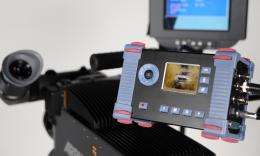The little giant of storage for the big screen

The "FlashBox" onboard recorder will soon make the work of film professionals easier: Truly diminutive in size, it stores digital film on exchangeable disks without compression. German researchers will be presenting the prototype at the International Broadcast Convention IBC in Amsterdam (September 11 to 15).
Gigantic volumes of data are involved with the production of digital motion pictures - shooting individual scenes alone requires somewhere between 20 to 50 gigabytes. In order to store this information on the set, a handy and high-performance recorder becomes indispensible. Researchers from the Fraunhofer Institute for Integrated Circuits IIS in Erlangen, Germany have developed a small storage box that docks directly onto the movie camera.
The recorder can record images for digital cinema and HD in a resolution of up to 2048 x 1080 pixels. It is also capable of storing Bayer raw sensor data and optionally JPEG2000 images. On the inside of the robust housing, Solid State Disks (SSD) operate in two slots so that the disks can be switched. Currently, this makes a total of 500 gigabytes available for storing the takes. The box is a mere 13 cm long, 8 cm wide and 7 cm deep (approximately 5.1 x 3.1 x 2.8 inches), and weighs 1,500 grams (around 3.3 pounds) without the SSD disks.
This solution tremendously simplifies the entire film production process. Digital movie cameras like the ARRI D21 or Sony F35 deliver uncompressed data that can be stored directly on the FlashBox. The device automatically detects the camera and data type for the respective camera model; alternatively, the appropriate recording format can be manually selected through the menu. The camera operator also gets additional information from this menu, such as a display of the space still available on the SSD disks, a take list and format settings. When filming is complete, the image data are shown in the take list. If the SSD disk is full, it can be switched out directly on the set via Plug&Play.
An adapter allows the film material to be loaded directly from the exchangeable disk to a server via USB or firewire. It can even be directly loaded with a SATA slide-in unit in the computer. The display through one of the preview outputs gives filmmakers the first impression of the filming. A control monitor for quality assessment can be attached through HDMI and HDSI interfaces.
FlashBox even benefits the post-production process. The uncompressed recording preserves the original camera quality. Stored Bayer raw data allow for optimal image processing; uncompressed image data ensure the maximum capability for correcting image dynamics and color adjustment.
A multi-level prompting process protects the recorded scenes on the FlashBox from being accidentally overwritten. The robust housing additionally guards the SSD disks from shocks and vibrations.
The onboard recorder will be available to beta testers starting in spring 2010. The research team is additionally working on solutions to integrate the storage solution into digital movie cameras, similar to a cassette.
Provided by Fraunhofer-Gesellschaft (news : web)

















